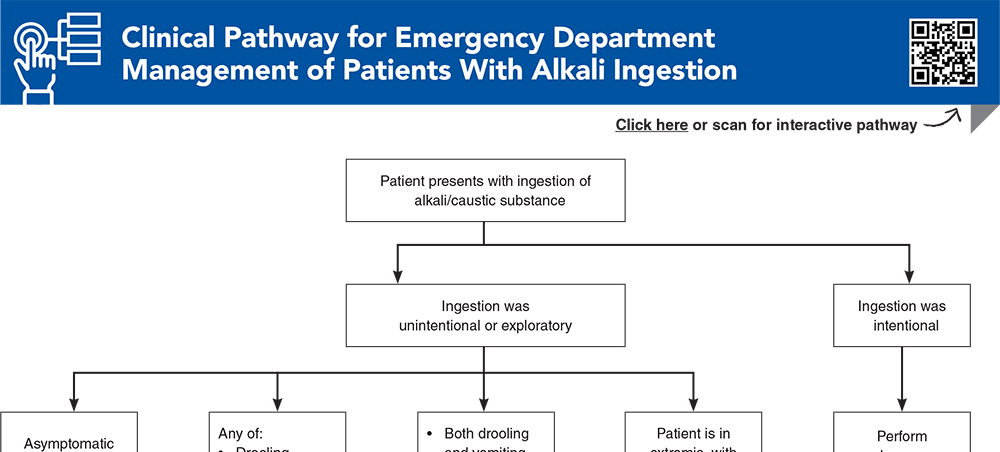

Alkali caustic exposures can occur in the workplace with industrial chemicals, or in the home with common household products. These exposures, whether accidental or intentional, create risk for death or acute injury, such as airway compromise and esophageal or gastric perforation, as well as long-term complications such as stricture formation. Swift diagnosis and grading of these injuries will guide management options and are essential to reduce morbidity and mortality in these patients. This issue reviews the evidence on emergency department management of alkali caustic exposures, with a focus on decontamination, resuscitation, and appropriate disposition.
How would you manage these patients? Subscribe for evidence-based best practices and to discover the outcomes.

Subscribe to access the complete Clinical Pathway to guide your clinical decision making.

Subscribe for full access to all Tables and Figures.
Buy this issue and
Following are the most informative references cited in this paper, as determined by the authors.
11. * Hoffman RS, Burns MM, Gosselin S. Ingestion of caustic substances. N Engl J Med. 2020;382(18):1739-1748. (Review) DOI: 10.1056/NEJMra1810769
23. * Chirica M, Resche-Rigon M, Zagdanski AM, et al. Computed tomography evaluation of esophagogastric necrosis after caustic ingestion. Ann Surg. 2016;264(1):107-113. (Prospective; 120 patients) DOI: 10.1097/SLA.0000000000001459
28. * Zargar SA, Kochhar R, Mehta S, et al. The role of fiberoptic endoscopy in the management of corrosive ingestion and modified endoscopic classification of burns. Gastrointest Endosc. 1991;37(2):165-169. (Prospective observational; 81 patients) DOI: 10.1016/s0016-5107(91)70678-0
30. * Usta M, Erkan T, Cokugras FC, et al. High doses of methylprednisolone in the management of caustic esophageal burns. Pediatrics. 2014;133(6):E1518-E1524. (Randomized controlled trial; 83 patients) DOI: 10.1542/peds.2013-3331
33. * Crain EF, Gershel JC, Mezey AP. Caustic ingestions. Symptoms as predictors of esophageal injury. Am J Dis Child. 1984;138(9):863-865. (Retrospective chart review; 79 patients) DOI: 10.1001/archpedi.1984.02140470061020
34. * Chirica M, Resche-Rigon M, Pariente B, et al. Computed tomography evaluation of high-grade esophageal necrosis after corrosive ingestion to avoid unnecessary esophagectomy. Surg Endosc. 2015;29(6):1452-1461. (Evaluation study; 197 patients) DOI: 10.1007/s00464-014-3823-0
36. * Chirica M, Bonavina L, Kelly MD, et al. Caustic ingestion. Lancet. 2017;389(10083):2041-2052. (Review) DOI: 10.1016/S0140-6736(16)30313-0
37. * Assalino M, Resche-Rigon M, Corte H, et al. Emergency computed tomography evaluation of caustic ingestion. Dis Esophagus. 2022;35(11):1-7. (Prospective, comparative study; 414 patients) DOI: 10.1093/dote/doac032
Subscribe to get the full list of 53 references and see how the authors distilled all of the evidence into a concise, clinically relevant, practical resource.
Keywords: alkali, caustic, ingestion, airway, esophagus, perforation, burn, decontamination, pH, Zargar, corticosteroid
Sukhshant Atti, MD, FACEP, FAAEM; Jessica Behrndt, MD; Alicia Hereford, MD
Charlotte E. Goldfine, MD; Edward Otten, MD, FACMT, FAWM
January 1, 2025
January 1, 2028 CME Information
4 AMA PRA Category 1 Credits™, 4 ACEP Category I Credits, 4 AAFP Prescribed Credits, 4 AOA Category 2-B Credits.